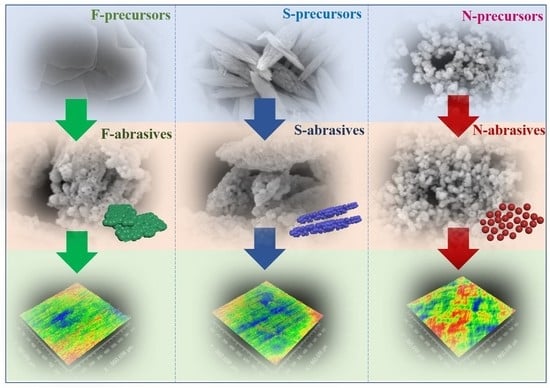The Effects of Precursors on the Morphology and Chemical Mechanical Polishing Performance of Ceria-Based Abrasives
Abstract
:1. Introduction
2. Materials and Methods
2.1. Chemicals and Materials
2.2. Synthesis of Ceria-Based Abrasives
2.3. Polishing Measurements
2.4. Characterization
3. Results and Discussion
4. Conclusions
Author Contributions
Funding
Conflicts of Interest
References
- Lim, D.S.; Ahn, J.W.; Park, H.S.; Shin, J.H. The effect of CeO2 abrasive size on dishing and step height reduction of silicon oxide film in STI-CMP. Surf. Coat. Technol. 2005, 200, 1751–1754. [Google Scholar] [CrossRef]
- Singh, R.K.; Bajaj, R.; Editors, G. Advances in chemical-mechanical planarization. MRS Bull. 2002, 27, 743–747. [Google Scholar] [CrossRef]
- Zantye, P.B.; Kumar, A.; Sikder, A.K. Chemical mechanical planarization for microelectronics applications. Mater. Sci. Eng. R Rep. 2004, 45, 89–220. [Google Scholar] [CrossRef]
- Krishnan, M.; Nalaskowski, J.W.; Cook, L.M. Chemical mechanical planarization: Slurry chemistry, materials, and mechanisms. Chem. Rev. 2010, 110, 178. [Google Scholar] [CrossRef] [PubMed]
- Pathak, D.; Bedi, R.K.; Kaur, D. Characterization of AgInSe2 films deposited by hot-wall vacuum evaporation method. Mater. Manuf. Processes 2010, 25, 1012–1017. [Google Scholar] [CrossRef]
- Kim, S.; Bark, C.W. Effect of Surface treatment by chemical-mechanical polishing for transparent electrode of perovskite solar cells. Energies 2020, 13, 585. [Google Scholar] [CrossRef] [Green Version]
- Ji, M.; Xin, Y.; Bo, J. Structure and application of polarizer film for thin-film-transistor liquid crystal displays. Displays 2011, 32, 49–57. [Google Scholar]
- Shiou, A.C. Some technical aspects of glass substrates for TFT-LCD applications. Glass Technol. 2003, 44, 148–151. [Google Scholar]
- Lee, H.; Kim, H.; Jeong, H. Approaches to sustainability in chemical mechanical polishing (CMP): A review. Int. J. Pr. Eng. Man-Gt. 2022, 9, 349–367. [Google Scholar] [CrossRef]
- Cook, L.M. Chemical processes in glass polishing. J. Non. Cryst. Solids 1990, 120, 152–171. [Google Scholar] [CrossRef]
- Sabia, R.; Stevens, H.J. Performance characterization of cerium oxide abrasives for chemical-mechanical polishing of glass. Mach. Sci. Technol. 2000, 4, 235–251. [Google Scholar] [CrossRef]
- Hoshino, T.; Kurata, Y.; Terasaki, Y.; Susa, K. Mechanism of polishing of SiO2 films by CeO2 particles. J. Non-Cryst. Solids 2001, 283, 129–136. [Google Scholar] [CrossRef]
- Wu, X.; Lei, H.; Chen, R.L. Preparation of porous alumina abrasives with different morphologies and their chemical mechanical polishing behavior. Adv. Mater. 2011, 338, 415–420. [Google Scholar] [CrossRef]
- Chandrasekaran, N. Material removal mechanisms of oxide and nitride CMP with celia and silica-based slurries—Analysis of slurry particles pre-and post-dielectric CMP. MRS Online Proc. Libr. (OPL) 2004, 816, 816–824. [Google Scholar]
- Liu, H.J.; Feng, Z.Y.; Huang, X.W.; Long, Z.Q.; Wang, M.; Xiao, Y.F.; Hou, Y.K. Study on purification and application of novel precipitant for ceria-based polishing powder. J. Rare Earths 2013, 31, 6. [Google Scholar] [CrossRef]
- Huang, S.D.; Liu, L.S.; Li, X.S.; Li, P.Z.; Guo, D.D. A Study on the preparation of rare earth polishing powder. Rare Earths 2002, 06, 46–49. (In Chinese) [Google Scholar]
- Wang, X.L.; Yi, S.Z.; Liang, E.W.; Wu, Y.Y.; Fang, Z.X. Study on preparation of polishing powder for LCD. Adv. Mat. Res. 2013, 785–786, 480–483. [Google Scholar] [CrossRef]
- Stachowiak, G.P.; Podsiadlo, P.; Stachowiak, G.W. Shape and texture features in the automated classification of adhesive and abrasive wear particles. Tribol. Let. 2006, 24, 15–26. [Google Scholar] [CrossRef]
- Kim, E.; Lee, J.; Park, Y.; Shin, C.; Kim, T. Shape classification of fumed silica abrasive and its effects on chemical mechanical polishing. Powder Technol. 2020, 381, 451–458. [Google Scholar] [CrossRef]
- Janoš, P.; Ederer, J.; Pilařová, V.; Henych, J.; Tolasz, J.; Milde, D.; Opletal, T. Chemical mechanical glass polishing with cerium oxide: Effect of selected physico-chemical characteristics on polishing efficiency. Wear 2016, 362, 114–120. [Google Scholar] [CrossRef]
- Wang, J.; Jin, Y.Z.; Wang, Z.B. Effect of fluoride incorporation on properties of rare earth polishing powders. Inorg. Chem. Ind. 2019, 51, 37–41. (In Chinese) [Google Scholar]
- Yang, G.S.; Cui, L.X.; Xie, B.; Wu, W.Y. Study on the effect of fluoride on the properties of ceria-based rare earth polishing powders. Rare Earth 2016, 37, 80–85. (In Chinese) [Google Scholar]
- Liu, S.G.; Zhang, P.; Li, M.; Hu, Y.H.; Wang, M.T.; Tao, B. Study on fluorine behavior in pure cerium rare earth polishing powder. Rare Earth 2014, 35, 13–18. [Google Scholar]
- Li, X.; Yang, G.; Wu, W.; Tu, G. Study on roast reaction kinetics and crystal behavior of ceria-based rare earth polishing powder. J. Rare Earths 2007, 25, 134–138. [Google Scholar]
- Jano, P.; Petrák, M. Preparation of ceria-based polishing powders from carbonates. J. Mater. Sci. 1991, 26, 4062–4066. [Google Scholar] [CrossRef]
- Li, Y.X.; Wang, X.L.; Ding, L.M.; Li, Y.; He, R.H.; Li, J. Changing the calcination temperature to tune the microstructure and polishing properties of ceria octahedrons. RSC Adv. 2022, 12, 16554. [Google Scholar] [CrossRef]
- Pei, W.L.; Dong, Z.; Xiang, H.C.; Wang, X.Y.; Yang, X.B.; Wang, J.J.; Li, Z.G.; Zhou, L.H. Evolution of the phases and the polishing performance of ceria-based compounds synthesized by a facile calcination method. RSC Adv. 2019, 9, 26996. [Google Scholar] [CrossRef] [Green Version]
- Qi, R.J.; Zhu, Y.J.; Cheng, G.F.; Huang, Y.H. Sonochemical synthesis of single-crystalline CeOHCO3 rods and their thermal conversion to CeO2 rods. Nanotechnology 2005, 16, 2502–2506. [Google Scholar] [CrossRef]
- Qian, L.W.; Wang, X.; Zheng, H.G. Controlled synthesis of three-fold dendrites of Ce(OH)CO3 with multilayer caltrop and their thermal conversion to CeO2. Cryst. Growth Des. 2011, 12, 271–280. [Google Scholar] [CrossRef]
- Oikawa, M.; Fujihara, S. Crystal growth of Ce2O(CO3)2·H2O in aqueous solutions: Film formation and samarium doping. J. Solid State Chem. 2005, 178, 2036–2041. [Google Scholar] [CrossRef]
- Mihalache, V.; Secu, M.; Grivel, J.C. Defect states and room temperature ferromagnetism in cerium oxide nanopowders prepared by decomposition of Ce-propionate. Mater. Chem. Phys. 2018, 209, 121–133. [Google Scholar] [CrossRef] [Green Version]
- Mayama, Y.; Koyabu, K.; Masui, T.; Tamura, S.; Imanaka, N. Synthesis of new red emitting phosphors based on rare earth oxycarbonates. J. Alloys Compd. 2006, 418, 243–246. [Google Scholar] [CrossRef]
- Kaczmarek, A.M.; Van, H.K.; Van, D.R. Nano-and micro-sized rare-earth carbonates and their use as precursors and sacrificial templates for the synthesis of new innovative materials. Chem. Soc. Rev. 2015, 44, 2032. [Google Scholar] [CrossRef]
- Zhang, Y.; Han, K.; Cheng, T.; Fang, Z. Synthesis, characterization, and photoluminescence property of LaCO3OH microspheres. Inorg. Chem. 2007, 46, 4713–4717. [Google Scholar] [CrossRef]
- Meher, S.K.; Rao, G.R. Tuning, via Counter Anions, the morphology and catalytic activity of CeO2 prepared under mild conditions. J. Colloid Interface Sci. 2012, 373, 46–56. [Google Scholar] [CrossRef]
- Praveen, B.; Cho, B.J.; Park, J.G.; Ramanathan, S. Effect of lanthanum doping in ceria abrasives on chemical mechanical polishing selectivity for shallow trench isolation. Mat. Sci. Semicon. Proc. 2015, 33, 161–168. [Google Scholar] [CrossRef]
- Jie, C.; Shuo, H.; Yang, L.; Wang, T.Q.; Xie, L.L.; Lu, X.C. RE (La, Nd and Yb) doped CeO2 abrasive particles for chemical mechanical polishing of dielectric materials: Experimental and computational analysis. Appl. Surf. Sci. 2020, 506, 144668. [Google Scholar]
- Krasinski, M.J.; Prywer, J. Growth morphology of sodium fluorosilicate crystals and its analysis in base of relative growth rates. J. Cryst. Growth 2007, 303, 105–109. [Google Scholar] [CrossRef]
- Gu, F.; Wang, Z.; Han, D.; Guo, G.; Guo, H. Crystallization of rare earth carbonate nanostructures in the reverse micelle system. Cryst. Growth Des. 2007, 7, 1452–1458. [Google Scholar] [CrossRef]
- Wang, Y.; Zhao, Y.; An, W.; Ni, Z.; Wang, J. Modeling effects of abrasive particle size and concentration on material removal at molecular scale in chemical mechanical polishing. Appl. Surf. Sci. 2010, 257, 249–253. [Google Scholar] [CrossRef]
- Suratwala, T.; Steele, W.; Feit, M.; Shen, N.; Dylla-Spears, R.; Wong, L.; Phil, M.; Richard, D.; Selim, E. Mechanism and simulation of removal rate and surface roughness during optical polishing of glasses. J. Am. Ceram. Soc. 2016, 99, 1974–1984. [Google Scholar] [CrossRef]
- Wang, L.; Zhang, K.; Song, Z.; Feng, S. Ceria concentration effect on chemical mechanical polishing of optical glass. Appl. Surf. Sci. 2007, 253, 4951–4954. [Google Scholar] [CrossRef]
- Kim, S.K.; Yoon, P.W.; Paik, U.Y.; Katoh, T.; Park, T.G. Influence of physical characteristics of ceria particles on polishing rate of chemical mechanical planarization for shallow trench isolation. Jpn. J. Appl. Phys. 2004, 43, 7427–7433. [Google Scholar] [CrossRef]
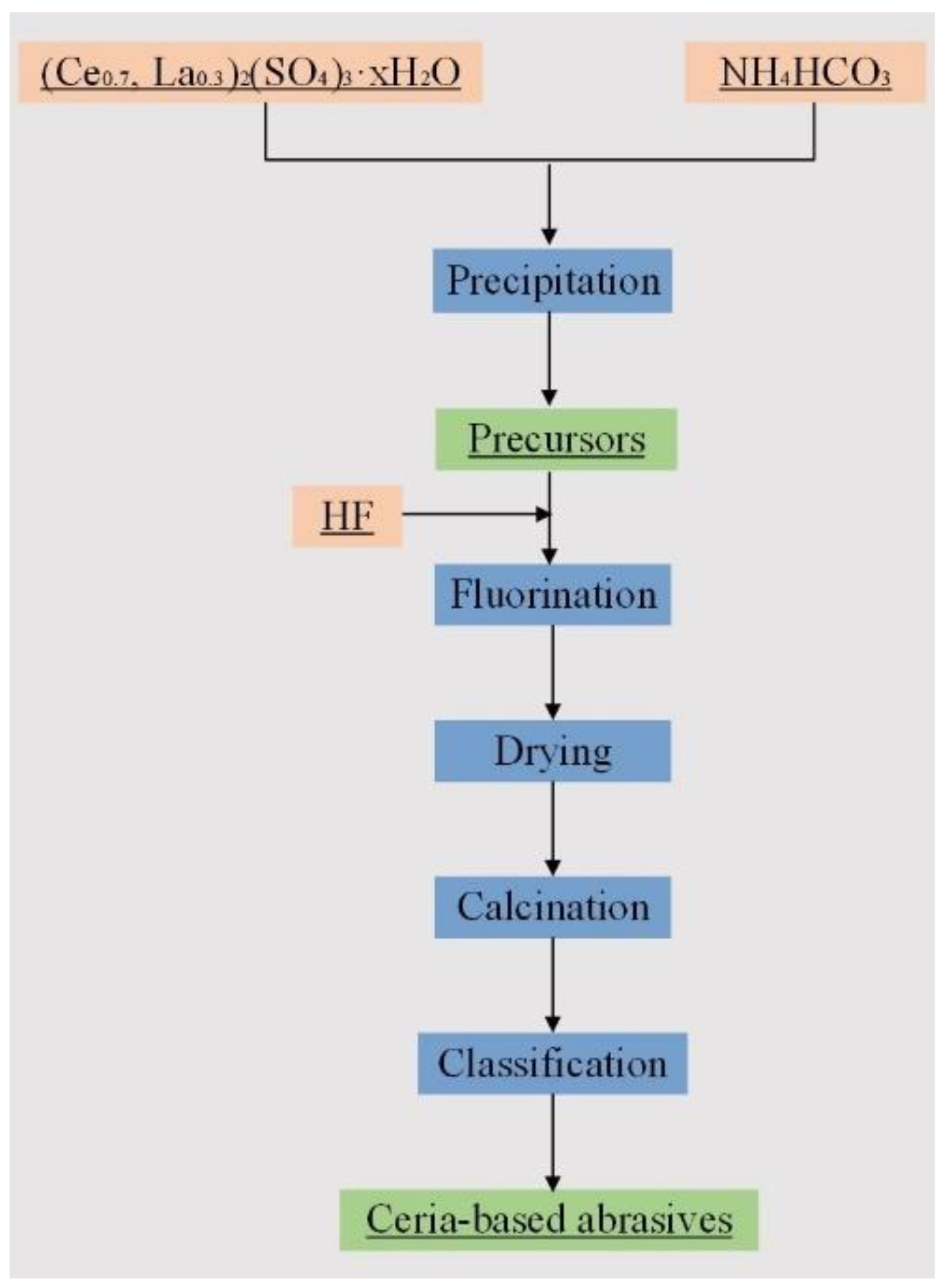
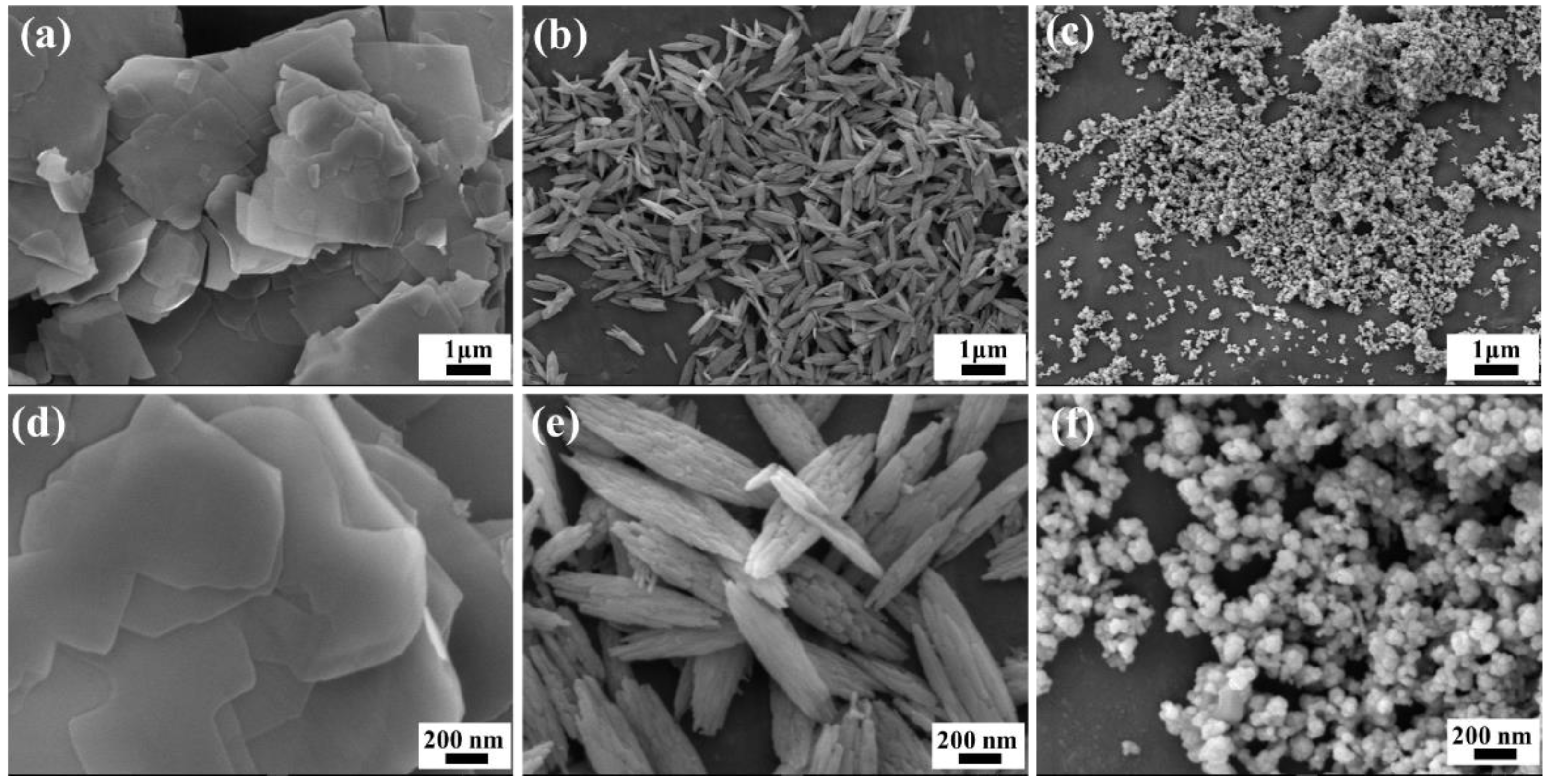
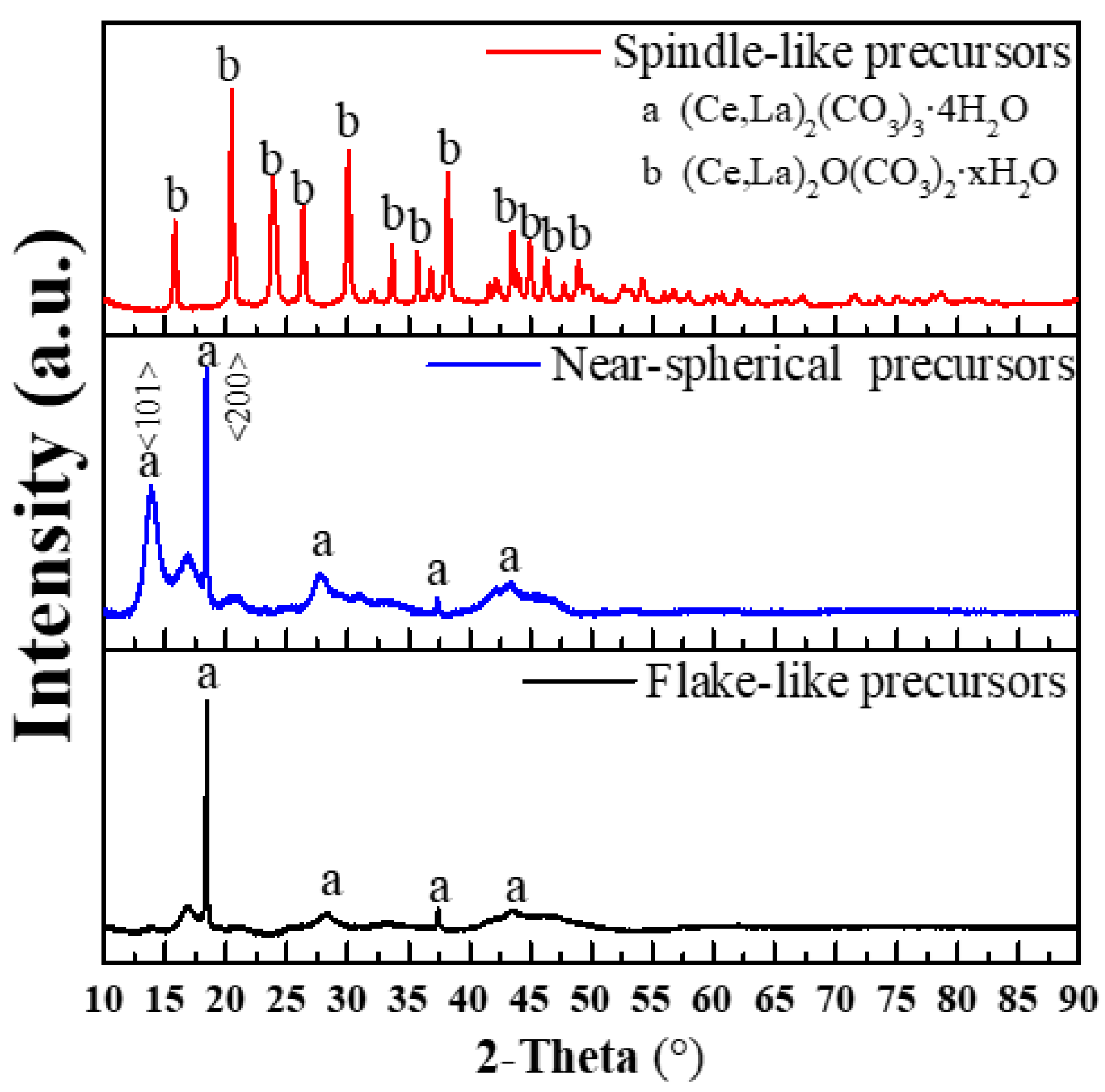


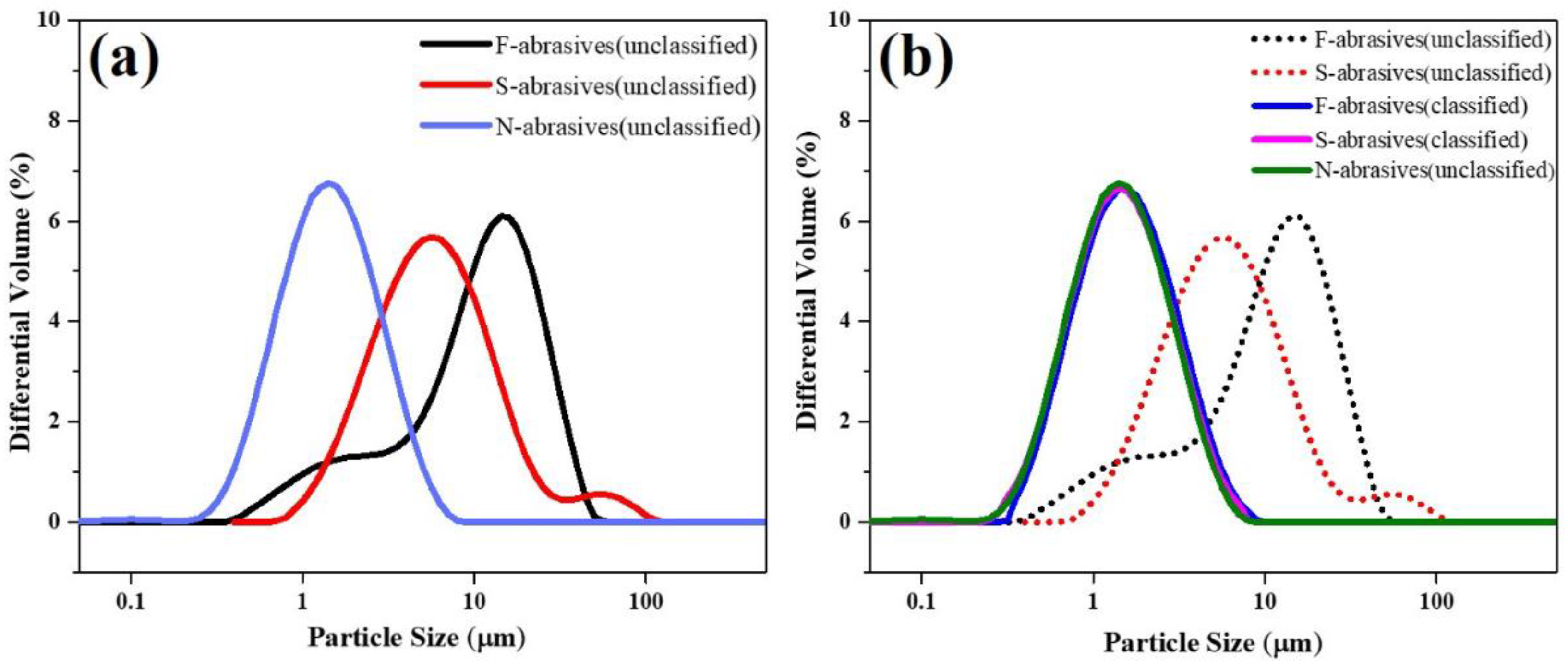



| Abrasives | Intensity-CeOX | Grain Size(nm)-CeOX | Intensity-LaOF | LaOF/CeOX |
|---|---|---|---|---|
| F-abrasives | 23,153 | 43.6 | 4055 | 0.175 |
| S-abrasives | 30,392 | 51.5 | 5294 | 0.174 |
| N-abrasives | 25,687 | 44.0 | 4600 | 0.179 |
Publisher’s Note: MDPI stays neutral with regard to jurisdictional claims in published maps and institutional affiliations. |
© 2022 by the authors. Licensee MDPI, Basel, Switzerland. This article is an open access article distributed under the terms and conditions of the Creative Commons Attribution (CC BY) license (https://creativecommons.org/licenses/by/4.0/).
Share and Cite
Zheng, Y.; Wang, N.; Feng, Z.; Tan, X.; Zhang, Z.; Han, H.; Huang, X. The Effects of Precursors on the Morphology and Chemical Mechanical Polishing Performance of Ceria-Based Abrasives. Materials 2022, 15, 7525. https://doi.org/10.3390/ma15217525
Zheng Y, Wang N, Feng Z, Tan X, Zhang Z, Han H, Huang X. The Effects of Precursors on the Morphology and Chemical Mechanical Polishing Performance of Ceria-Based Abrasives. Materials. 2022; 15(21):7525. https://doi.org/10.3390/ma15217525
Chicago/Turabian StyleZheng, Yuanyuan, Ning Wang, Zongyu Feng, Xianmin Tan, Zhenyu Zhang, Huiqing Han, and Xiaowei Huang. 2022. "The Effects of Precursors on the Morphology and Chemical Mechanical Polishing Performance of Ceria-Based Abrasives" Materials 15, no. 21: 7525. https://doi.org/10.3390/ma15217525
APA StyleZheng, Y., Wang, N., Feng, Z., Tan, X., Zhang, Z., Han, H., & Huang, X. (2022). The Effects of Precursors on the Morphology and Chemical Mechanical Polishing Performance of Ceria-Based Abrasives. Materials, 15(21), 7525. https://doi.org/10.3390/ma15217525




